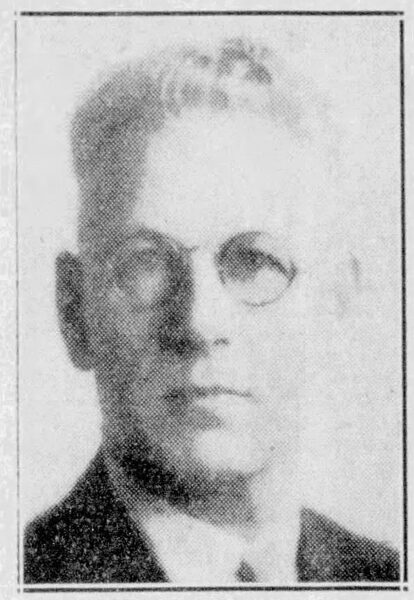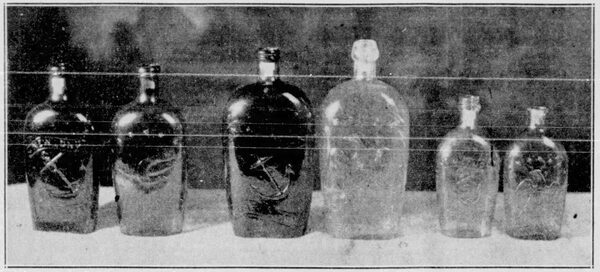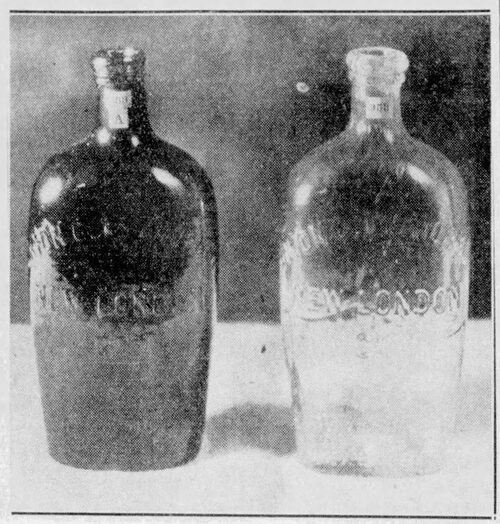[Newspaper]
Publication: The Day
New London, CT, United States
vol. 53, p. 10, col. 1-8
New London Home of Bottle Factory Nearly 80 Years Ago
Organized in August, 1856
Began Operations in 1857;
Made Two Types of Bottles
Flasks Are Not Very Well
Known But Very Attractive
For Their Clear Colors
The article below was written by Charles B. Gardner of 560 Montauk avenue for the American Collector.
By CHARLES B. GARDNER
The New London Glass Co. and its products have received little attention from collectors, no doubt because of its limited output and its comparative lateness in the field of glass manufacture.
As a collector of flasks, which were apparently, the major output of the New London Glass Co. and as I am interested in obtaining all the knowledge possible of old glass factories, I felt particularly called upon to seek out what information I could concerning this factory located in my own home town.
COLLECTOR OF BOTTLES
| |||
| CHARLES B. GARDNER |
By referring to old directories, newspapers, records in the city hall and by conversation with two former workmen at the New London Glass factory. I have collected the following information which I am pleased to submit to your readers.
It was organized on August 27, 1856, with a capital stock of $12,000. The officers were N. S Perkins, Jr. president, and Lorenzo Hodsden, secretary and treasurer. The directors were N. S. Perkins, Jr., Lorenzo Hodsden, Leonard Shaffer, Daniel Shaffer, Thomas W. Perkins. The company, however, did not operate during 1856, as a site for the factory was not purchased until October 10, 1857, in the Fort Neck section. This tract was 250 feet square and was bounded by Smith, Goshen, and Trumbull streets.
Started in 1857
The factory probably started operations late in 1857 for the New London Directory for 1857-58 gives, in addition to the names of the officers those of Mr. Dexter, Howard street, and James Shaffer, 9 Coit street, as glass workers. N. S. Perkins, Jr., was a member of the firm of Perkins and Smith, ship agents and lived in Waterford; Lorenzo Hodsden boarded on Huntington street, and T. W. Perkins boarded at 87 Bank street, the home of Dr. Perkins. It is apparent from the small capital invested and the few glass workers listed that the output at this time could not have been very great, The fact that the directory was only published every two years might be the reason for more glass workers not being listed.
FLASKS MANUFACTURED BY THE NEW LONDON GLASS WORKS
| |||
| From right to left are the three designs in which flasks of this make are found. |
We do know, however, that this factory produced two types of blown flasks; one with a large eagle, head to the left under seven stars, on the quart flask, and under nine stars on the half pint flask, perched on a large wreath of leaves. On the reverse there was New London on a ribbon over an anchor, and a rope over Glass Works, also on a ribbon. This bottle comes in quarts and half pints, in clear glass, aquamarine, and light and dark amber. The other flask seems to he confined to the pint size only, carrying on one side a very curious eagle in flight headed to the right under seven stars, and on the reverse side, New London on ribbon over anchor and rope and Glass Works on ribbon. The flasks have been found in light and dark amber glass.
Attractive For Clear Colors
While New London flasks are not particularly well known, they are attractive for their clear colors, especially the flask with the eagle in flight which is uncommon. As the names of Lorenzo Hodsden. N. S. Perkins, Jr., Dexter D. Shaffer and J. Shaffer do not appear in the directory for 1859, it would appear that they had left the firm.
While the New London Glass Co. is listed in the directory of 1859-60 with Messrs. Warren & Co., as proprietors, neither the Warrens nor any glass workers are listed. Therefore, it seems probable that the factory was not operating in 1859 when the directory was published. We have no further knowledge of the products of this factory under the above name and, unfortunately, are prevented from gaining further information as the dumping pile at its site has been removed to make room for a coal pile, now owned by the City of New London and used for storage purposes.
Continually Changing Hands
Glass houses were continually changing hands and at New London this same condition prevailed. On September 24, 1859, the Union Glass Works purchased the factory from Charles Prentis. As this transaction involved a tract of land 500 feet square the original company had made additions to their initial holdings. Little is known of the products of the Union Glass Co. but I have in my collection two pint flasks, one in clear brilliant, very bubbly glass, and the other in a rich deep olive amber, marked Union Glass Works, New London, Conn., with the reverse side plain; also, several mineral water bottles. This company or its workmen are not listed in any directory.
MADE BY THE UNION GLASS WORKS
| |||
| Both are pint sizes. That at the left is a deep olive amber in color and that on the right a clear brilliant bubbly glass. |
In the directory of 1863-64 there is no mention of the glass works or workers but under date of August 13, 1863, the New London Chronicle carried the following: "It is reported that the glass works near Fort Trumbull which has been idle has been purchased by a gentleman at Stonington and is to be operated." Thirteen days later this same newspaper states that "William Barry and Nathan S. Fish of Mystic are the persons who have purchased the glass works near Fort Trumbull. Alterations are being made and manufacturing operations are soon to start at the plant." Under the date of December 22. 1864, the Norwich Weekly Courier mentions that "The Thames Glass Works Company are manufacturing a large amount of light and dark green glass. The company has a first rate reputation."
The Greatest Period of Prosperity
The factory probably enjoyed its greatest period of prosperity between 1864-66 as the directory for 1865-66 in listing the Thames Glass Works, Fort Neck, gives the names of Nathan C. Fish, manager, and the following as glass blowers: Peter Benard, Smith street, William Brophy, Smith street, Patrick McCardell, Smith street, John Smith, 51 Bank street, John J. Squire, 173 Main street, Christopher Trainy, Smith street, Carlos W. Foster, Bank street and William Johnson, 41 Bank street. The glass workers were Jacob Felton, Prest street, John Rockwell, Cape Ann lane. Horatio R Smith, Smith street and N S. Fish. Manager, 134 Main street. As most of the above men boarded it would bear out the statement of two surviving employes of the Thames Glass Works that most of the workmen came from Philadelphia.
The only marked piece I have from this factory is a deep amber telegraph insulator bearing the name, Thames Glass Works, New London, Conn. Among the fragments picked up on the old site were two crude jar caps marked Paid. Oct. 18th, 1864.
Bernard Quigley and Thomas Roche, formerly employed at the plant, looked over my collections of bottles and recollected that many of the pickle bottles, demijohns and vials were similar to those they saw made in the factory. As they were boys at the time, their recollections are rather vague, but Mr. Roche did have a rolling pin which a workman made for him and I have duplicates in clear and blue glass.
Offhand Pieces
In most factories the workmen made offhand pieces to give to visitors or to their friends, but few of such pieces could have been made, perhaps because of the class of work being produced at the factory. At any rate, only one piece has turned up that might be classified as New London Glass and that is the property of George S. McKearin. I have searched and advertised for pieces like this but without success.
The New London Chronicle of October 20, 1866, gave a very interesting description of the plant and operation under the heading Fort Trumbull Glass Works, as follows: "This establishment, was put in operation in December, 1865, by the company now owning it. The officers of the company are: president, D. S. Calhoun; secretary and treasurer, N. Hendricks; agents. J. R. Gilbert and H. G. Foster. Since the company have come into possession they have put in new furnaces, enlarged the works and their capacity is now nearly double what it was. They give employment to about 80 men and boys in the different departments. Through the kindness of Mr. Hendricks, the gentlemanly and obliging superintendent, we were shown the most interesting features of the works a day or two ago.
Wooden Building
"The factory proper is a wooden building, 90 feet long by 61 feet wide. In the building are the furnaces, ovens, pipes, etc. for melting and blowing the glass. The glass is first placed in the pots which are fixed in the furnaces overnight and a very hot fire is kept up all through the night until morning, when the blowers commence operations. The glass is taken from the pots on iron pipes and rolled to make it even on a slab. It is then placed in the proper kind of mould and the glass is blown to the required shape.
"The manner of blowing the glass is very interesting. After the bottles have been made into the required shape they are placed in ovens to be annealed. Here they remain about three days and then are taken to a small building which adjoins the main building where the packing is done. The bottles or carboys are all packed away in tiers in stout wooden boxes with a laver of hay or straw for each tier. There are about five tons of material used per day and as a good part of the manufactures are small vials the packing requires a large amount of labor.
The company is now manufacturing bottles for Perry Davis’ Pain Killer, Dr. Ford’s Pectoral Syrup, Wilbur’s Rheumatic Medicine, Rings’ Ambrosia, Knowles’ Hair Invigorator, Hyatt’s Life Balsam, and various other preparations. They make all kinds of green and amber bottle ware, from the small half ounce vial to the fifteen gallon carboy. Some of the specimens which we were shown were fully as perfect as anything we commonly see in that line. Besides the other buildings, there is a building which contains a room and implements for the manufacture of the clay pots which hold the glass.
Blacksmith Shop
There is also a blacksmith’s shop, in which the iron work for the establishment is done. The pipes for blowing the glass are made in this shop. They cannot be kept in good order but for a day or two and consequently there are a large number of pipes made in the space of a month. There is an engine room connected with this establishment which supplies the necessary power. The works are well managed and kept. Special attention is paid to the time and manner of doing the work. We happened to be in the superintendent’s office as several of the men and boys were being paid and from what we saw we concluded that though Mr. Hendricks might be a strict officer, he was very kind hearted man. We always like to testify to kindness wherever we see it, and we hardly think that the workmen in the establishment which Mr. Hendricks superintends could find a man who would use them any better than he."
Last To Operate
As far as the records show the Thames Glass Works were the last to operate the factory under the management of Mr. Hendricks, whom we find listed in the directory for 1870-71 as engaged in selling fruit jars at 14 Tilley street, and J. R. Gilbert, one of the agents, as also dealing in fruit jars at Rank street and residing at 18 Tilley street. These gentlemen Were probably disposing of the stock of glass jars which were on hand at the factory when it shut down.
I have talked with many of the older inhabitants of New London about this glass works. Some can remember seeing the glass blowers working; others recollect playing as boys around the old abandoned factory in the clean white sand and much to the regret of the present day collector, pegging rocks at innumerable glass bottles which they never expected would have any value.
While this factory was not very long in existence compared with other industries, it would seem that someone should have a photograph or drawing of this old group of buildings which has come to be one of New London's almost forgotten industries of the past.
WORKED AT FACTORY
Edward S. Neilan Employed There
During Summer of 1874
Edward S. Neilan of 1165 Ocean avenue, proprietor of Tate and Neilan, recalls the summer vacation of 1874 he spent working at the glass factory. At the time, George D. Whittlesey, later postmaster of New London, was employed in the offices of the plant and several local boys were hired in the summer to work in the factory.
Mr. Neilan's duties consisted of closing the mould around the glass while the glassblower blew into it, and then carrying the bottle to the "gloryhole" where the neck of the bottle was shaped.
A general idea of the whole process will no doubt, tend to clarify the description of Mr. Neilan's duties.
In the main room of the factory was located the huge oven, appropriately termed the "beehive" because of its resemblance, where the glass was mixed. This was round, about 25 feet in diameter, and tapered up to a point at the top, much like a beehive.
A platform ran around the beehive and at intervals along the sloping walls, were apertures through which the clay pots inside could he seen. A wood fire kept the oven hot and the glass plastic.
Ready For Moulding
While the oven was cold, the silica, sand and other ingredients were put in the large clay pots inside the furnace. Then the fire was started and let burn overnight so that when the workers arrived in the morning, the glass would be ready for moulding.
The blowers climbed to the platform in front of their respective holes in the beehive and the helpers took their places behind them. Taking a long, hollow, steel pipe, the blower stuck one end into the clay pot through the hole, dipped up a mess of the sticky, hot glass, and withdrew the pipe. Then he turned his back to the beehive and, rolling the wad of back and forth on a metal block, he blew into the other end of the pipe, expanding the wad of glass.
When the glass began to take shape, he stuck it down into a mould. The mould consisted of two semi-circular sections, hinged together, with a wooden handle attached to each half. As the blower inserted the glass into the mould, the handles were pulled together. Closing the mould around the glass. This was Mr. Neilan's duty.
The blower, huffing and puffing through the pipe, which protruded from a hole in the top of the mould, compressed the glass against the inside wall of the mould, conforming it to the shape desired. Different sized moulds were used, varying from the very small ones used to make small vials, to the large ones in which the carboys were blown.
Blower’s Pipe Removed
The mould was then opened, the blowers pipe removed from the neck of the bottle, and the bottle carried in a wire cup to the "glory-hole". This was Mr. Neilan's next duty.
At the gloryhole, a small furnace, the neck of the bottle was reheated and the worker there formed the shape of the bottles neck with a piece of metal.
The bottle was then carried to another larger oven where it was kept heated for two or three days at an even temperature with many other finished bottles. The purpose of this second heating process was to anneal the bottles. They were then carried to the packing department for shipment.
Mr. Neilan's job it was to sit behind the blower, close the mould around the glass, remove the bottle, carry it to the glory hole, some ten feet distant and return to the mould in time to catch the blower's next mass of glass.
James Keefe, who is now employed at the hospital, was another of the boys who worked with Mr. Neilan at the factory during the vacation.
Whiskey Bottles Chief Product
Whiskey bottles were the chief product of the factory although all kinds were manufactured, men were paid by piece work. It was exceedingly hot work for the blowers, who stood all day in front of the whole of the blazing beehive. Mr. Neilan estimates about 80 men were employed there.
Oftentimes, the clay pots which held the glass in the beehive would crack and then the work would have to stop while the fire was put out. Then, when the beehive had cooled sufficiently to allow it, a new clay pot was installed.
The factory was located near where Smith street extension is now. Mr. Neilan remembers playing baseball in the factory yard during the lunch hour. Sometimes too, after the plant had stopped running, he and some other boys used to set up the old bottles that were left lying around the yard and throw stones at them. Little did the boys realize then that the old, abandoned bottles would ever be worth anything.


